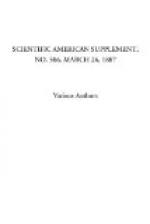When an article has been nickel plated, it generally presents a dull appearance, resembling frosted silver. To get over this I tried, some time ago, the use of bisulphide of carbon in the same way as used for obtaining a bright silver deposit. Curiously the deposit was very dark, almost black, which could not be buffed or polished bright. But by using a very small quantity of the bisulphide mixture, the plated surfaces were so bright that the use of polishing mops or buffs could be almost dispensed with. When we consider the amount of labor required in polishing a nickel plated article, and the impossibility of finishing off bright an undercut surface, this becomes an important addendum to the nickel plater’s list of odds and ends.
This mixture is made precisely in the same way as for bright silvering, but a great deal less is to be added to the bath, about one pint per 100 gallons. It should be well stirred in, after the day’s work is done, when the bath will be in proper condition for working next day. The mixture is made by shaking together, in a glass bottle, one ounce bisulphide and one gallon of the plating liquid, allow to stand until excess of bisulphide has settled, and decant the clear liquid for use as required. It is better to add this by degrees than to run the risk of overdoing. If too much is added, the bath is not of necessity spoiled, but it takes a great deal of working to bring it in order again.
About eight ounces of the double sulphate to each gallon of distilled or rain water is a good proportion to use when making up a bath. There is a slight excess with this. It is a mistake to add the salt afterward, when the bath is in good condition. The chloride and cyanide are said to give good results. I can only say that the use of either of these salts has not led to promising results in my hands.
In preparing the double sulphate, English grain nickel is decidedly the best form of metal to use. In practice, old anodes are generally used.
The metal is dissolved in a mixture of nitric and dilute sulphuric acid, with the application of a gentle heat. When sufficient metal has been dissolved, and the unused nitric acid expelled, the salt may be precipitated by a strong solution sulphate of ammonia, or, if much free acid is present, carbonate of ammonia is better to use.
Tin, lead, and portion of the iron, if present, are removed by this method. The silica, carbon, and portions of copper are left behind with the undissolved fragments of metals.
The precipitated salt, after slight washing, is dissolved in water and strong solution ammonia added. A clean iron plate is immersed in the solution to remove any trace of copper. This plate must be cleaned occasionally so as to remove any reduced copper, which will impede its action. As soon as the liquid is free from copper, it is left alkaline and well stirred so as to facilitate peroxidation and removal of iron, which forms a film on the bath. When this ceases, the liquid is rendered neutral by addition of sulphuric acid, and filtered or decanted. The solution, when properly diluted, has sp. gr. about 1.06 at 60 deg. F. It is best to work the bath with a weak current for a short time until the liquid yields a fine white deposit. Too strong a current must be avoided.




